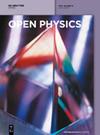Robustness and dynamical features of fractional difference spacecraft model with Mittag–Leffler stability
IF 1.8
4区 物理与天体物理
Q2 PHYSICS, MULTIDISCIPLINARY
引用次数: 0
Abstract
Spacecraft models that mimic the Planck satellite’s behaviour have produced information on cosmic microwave background radiation, assisting physicists in their understanding of the composition and expansion of the universe. For achieving the intended formation, a framework for a discrete fractional difference spacecraft model is constructed by the use of a discrete nabla operator of variable order containing the Mittag–Leffler kernel. The efficacy of the suggested framework is evaluated employing a numerical simulation of the concerning dynamic systems of motion while taking into account multiple considerations such as exterior disruptions, parameterized variations, time-varying feedback delays, and actuator defects. The implementation of the Banach fixed-point approach provides sufficient requirements for the presence of the solution as well as a distinctive feature for such mechanisms Furthermore, the consistent stability is examined. With the aid of discrete nabla operators, we monitor the qualitative behavioural patterns of spacecraft systems to provide justification for structure’s chaos. We acquire the fixed points of the proposed trajectory. At each fixed point, we calculate the eigenvalue of the spacecraft system’s Jacobian matrix and check for zones of instability. The outcomes exhibit a wide range of multifaceted behaviours resulting from the interaction with various fractional orders in the offered system. To maintain stability and synchronize the system, nonlinear controllers are additionally provided. The study highlights the technique’s vulnerability to fractional-order factors, resulting in exclusive, changing trends and equilibrium frameworks. Because of its diverse and convoluted behaviour, the spacecraft chaotic model is an intriguing and crucial subject for research.具有 Mittag-Leffler 稳定性的分数差分航天器模型的鲁棒性和动力学特征
模仿普朗克卫星行为的航天器模型产生了有关宇宙微波背景辐射的信息,有助于物理学家了解宇宙的构成和膨胀。为了实现预期的形成,利用包含 Mittag-Leffler 核的可变阶离散 nabla 算子,构建了离散分数差分航天器模型的框架。在考虑到外部干扰、参数化变化、时变反馈延迟和致动器缺陷等多种因素的情况下,通过对相关动态运动系统进行数值模拟,对所建议框架的有效性进行了评估。巴拿赫定点法的实施为求解的存在提供了充分条件,也为此类机制提供了显著特征。借助离散纳布拉算子,我们监测了航天器系统的定性行为模式,为结构混沌提供了依据。我们获取了建议轨迹的固定点。在每个固定点,我们计算航天器系统雅各布矩阵的特征值,并检查不稳定区域。结果表明,在所提供的系统中,由于各种分数阶的相互作用,出现了多种多样的行为。为了保持系统的稳定性和同步性,还额外提供了非线性控制器。该研究强调了该技术易受分数阶因素影响的脆弱性,从而导致独有的、不断变化的趋势和平衡框架。由于其行为的多样性和复杂性,航天器混沌模型是一个引人入胜的重要研究课题。
本文章由计算机程序翻译,如有差异,请以英文原文为准。
求助全文
约1分钟内获得全文
求助全文
来源期刊

Open Physics
PHYSICS, MULTIDISCIPLINARY-
CiteScore
3.20
自引率
5.30%
发文量
82
审稿时长
18 weeks
期刊介绍:
Open Physics is a peer-reviewed, open access, electronic journal devoted to the publication of fundamental research results in all fields of physics. The journal provides the readers with free, instant, and permanent access to all content worldwide; and the authors with extensive promotion of published articles, long-time preservation, language-correction services, no space constraints and immediate publication. Our standard policy requires each paper to be reviewed by at least two Referees and the peer-review process is single-blind.
 求助内容:
求助内容: 应助结果提醒方式:
应助结果提醒方式:


